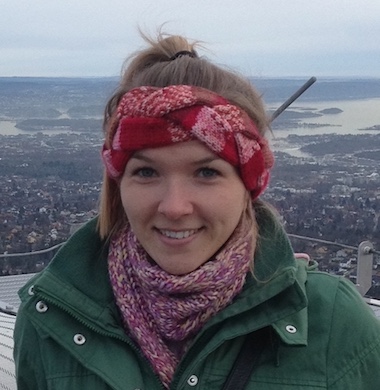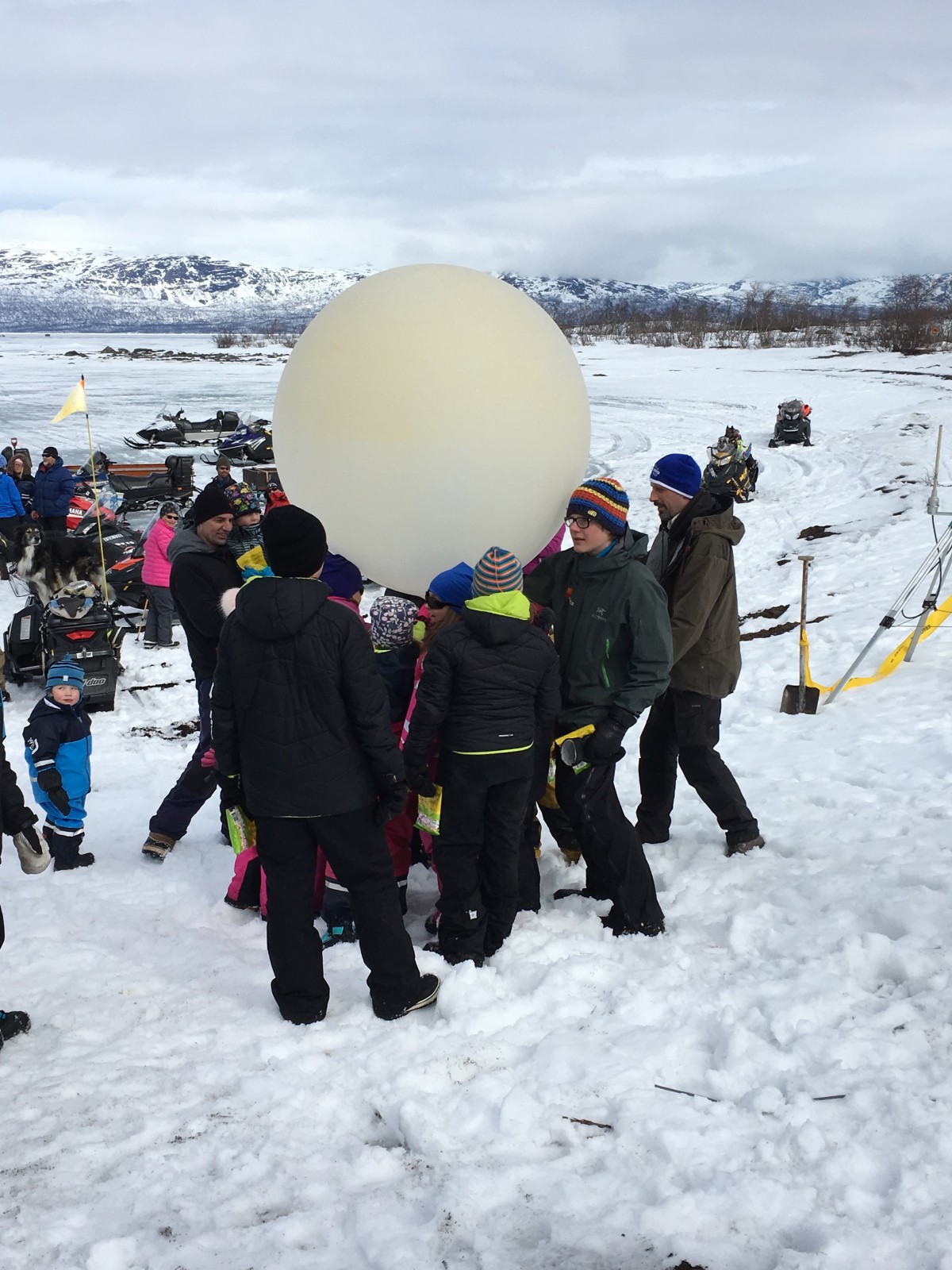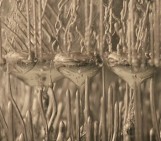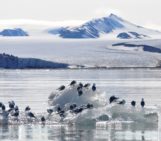
Early career scientists studying polar climate are one lucky group! The 29 young scientists who took part in the 10 day Polar Prediction School this year were no exception. They travelled to Arctic Sweden to learn and discuss the challenges of polar prediction and to gain a better understanding of the physical aspects of polar research.
The Year of Polar Prediction
The Year of Polar Prediction (YOPP) was launched on May 15th 2017; a large 2 year project that ‘aims to close gaps in polar forecasting capacity’ and ’lead to better forecasts of weather and sea-ice conditions to improve future environmental safety at both poles’. With these aims in mind, and with the support of the related APPLICATE project and the Association for Polar Early Career Scientists (APECS), a ten day Polar Prediction School took place in Abisko, Sweden in mid-April.
Abisko is a little town of 85 inhabitants, located north of the Arctic Circle (68°N) next to a National Park and a large lake. Due to the interesting habitats found in the region it is an excellent place to undertake polar research. Consequently, a scientific research station is located in the town, where research mainly focuses on biology, ecology, and meteorology.

Heading back to the research station (seen at the back of the picture) after a long hike [Credit: C. Burgard].
The 29 school participants were made up of Master students, PhD students, and PostDocs, with some studying the Arctic and some the Antarctic. The participants had diverse research backgrounds, with research that focused on atmospheric sciences, oceanic sciences, glaciers, sea ice and hydrology of polar regions, and used a range of techniques, from weather or climate models to in-situ or satellite observations. However, in the end, we were all linked together by our interest in the polar regions. Both this diversity and this link in our research helped us to exchange ideas about the common issues and the differences in all our disciplines.
The school programme
The course aimed to broaden students’ knowledge around their very specific PhD area. Therefore, the school covered a huge range of topics including polar lows, polar ocean-sea ice forecasting, remote sensing of the cryosphere, boundary layers, clouds and much more! Each day was made up of a mixture of lectures and practical sessions, which included:
- Computer modelling exercises, for example using a simple 1D sea ice model
- Observations, which included measuring temperature and wind from a weather station on the frozen lake next to the station, and daily radiosonde launches at lunchtime, in sync with radiosonde launches worldwide. These results were compared to model predictions each day.
- Data assimilation, which focused on understanding the shortcomings in reanalysis products that we all use, including sources of uncertainty and error in the products and how they may impact our own work.
After dinner each evening a different group gave an informal weather briefing for the next day, which was often condensed down to how cloudy it would be, the amount of snow predicted (very little), and temperature (which averaged 2-3°C). Not quite the harsh, sub-zero temperatures that most of us had packed for! Each day was broken up by two coffee breaks (always accompanied by an obligatory cinnamon roll!) and meals which were taken all together in the main research building. This dragged everyone out of the lecture room to chat and refresh before the next session.

As is usual for any worthwhile meteorological fieldwork, we installed a small weather mast on the lake [Credit: C. Burgard].
Living Arctic weather for real
The usual weather in Abisko during April is fairly dry with temperatures ranging from 2°C to -6°C. In preparation for the cold, most of us had brought an abundance of wooly jumpers, thick thermal layers and numerous pairs of socks. However, on arrival in Abisko, the sun was shining and it was a balmy 7°C for the first two days. Whilst erecting the meteorology mast many of us were wearing T-shirts and sunglasses, after abandoning our warmer gear. The warm weather was not to last! Cloudy, relatively mild (2°C to -2°C) conditions persisted throughout most of the week, and it remained dry, which made it easier to forecast the weather but we were all hoping for a little snow! Finally, on the final day of the summer school, large snowflakes fell, although sadly it all melted quite quickly.
When we arrived, the whole area was coated in a thick layer of white snow and the frozen lake was covered. However, by the end of our visit, the bare earth was visible, and the top of the lake was slushy puddles of water. The changes in weather throughout the summer school made for interesting observation records. The albedo (reflectivity) of the lake surface went from approximately 0.8 for the fresh, white snow, but was reduced to 0.4 for the darker, water covered lake surface. It was great to see some theory in action!
Exploring the region
Luckily, we were also given a free day , in which we could explore the region, go skiing or just relax. One large group went off hiking, whilst a smaller group went cross country skiing and a few had a walk to the nearby frozen waterfall. But don’t worry, the science still continued! A group of 3 people stayed close by to release the lunchtime radiosonde.
Our visit to the area coincided with the exciting annual ice fishing contest! Whilst cars and small DIY tools are common place in many cities, in Abisko it is a snow mobile (or skidoo) and an ice drill, so they were well versed in the art of ice fishing! The majority of the town’s occupants arrived at the lake and started drilling small holes to catch some fish. After two hours, a number of prizes were awarded (e.g for the longest fish caught). Unfortunately, some of the holes were a little too close to our meteorology mast, and some cables were pulled out, but thankfully we still collected some good data!
An important aspect of any research is engaging with the local communities and communicating effectively with them. So all of the summer school attendees gathered by the lake to watch the ice fishing contest, and a large number of the children from Abisko gathered to watch us release the radiosonde, even helping launch one. They found our activities just as exciting as we found theirs!
And we did some science communication as well!
A crucial aspect of science is how you communicate it to a variety of audiences. The way you might discuss your thesis to your viva panel should be completely different to the way you describe your science to your Great Aunt Linda or to a group of 10-year olds who are attending your outreach event. As part of the summer school, we learnt a range of tips and tricks for communicating science, thanks to Jessica Rohde. Jess is the communications officer for IARPC (Interagency Arctic Research Policy Committee) Collaborations and has years of science communication experience under her belt. Each evening we had a short lecture by Jess, which focused on a specific area of communication including presentation slide design, knowing your audience, listening to the audience and finding the story behind your science. Once we had learnt the theory we then put what we had learnt into practice. We did a bit of improv’, which included 1-minute elevator pitches and tailoring your science to taxi drivers, the Queen of England and models (no not computer models, the Kate Moss variety). An important take-home message was that there is no such thing as the ‘general public’. When designing your outreach event, the ‘general public’ could involve children of all ages (and therefore all learning levels), parents, teachers, professors and pensioners. Therefore, you should listen to the needs of your audience and understand what their motivation is.
You can check out the final results of these sessions here!
In summary…
In the end, although the school was quite intense, everyone was sad to part. We are sure we will all remember this exciting time, where we learnt about the many aspects of polar prediction, and what to consider when tackling science communication. We hope that this school will be organized again in the next years to provide this amazing and unforgettable experience to all those who could not join this year’s Polar Prediction School!
Further reading
- Polar Prediction School website
- APECS website
- Year of Polar Prediction website
- APPLICATE website
Edited by Morgan Jones
 Rebecca Frew is a PhD student at the University of Reading (UK). She investigates the importance of feedbacks between the sea ice, atmosphere and ocean for the Antarctic sea ice cover using a hierarchy of climate models. In particular, she is looking at the how the importance of different feedbacks may vary between different regions of the Southern Ocean.
Rebecca Frew is a PhD student at the University of Reading (UK). She investigates the importance of feedbacks between the sea ice, atmosphere and ocean for the Antarctic sea ice cover using a hierarchy of climate models. In particular, she is looking at the how the importance of different feedbacks may vary between different regions of the Southern Ocean.
Contact: r.frew@pgr.reading.ac.uk
 Jenny Turton is a post doc working at the institute for Geography at the University of Erlangen-Nuernberg, in the climate system research group. Her current research focuses on the interactions between the atmosphere and surface ice of the 79N glacier in northeast Greenland, as part of the GROCE project.
Jenny Turton is a post doc working at the institute for Geography at the University of Erlangen-Nuernberg, in the climate system research group. Her current research focuses on the interactions between the atmosphere and surface ice of the 79N glacier in northeast Greenland, as part of the GROCE project.
 Clara Burgard is a PhD student at the Max Planck Institute for Meteorology in Hamburg. She investigates the evolution of sea ice in general circulation models (GCMs). There are still biases in the sea-ice representation in GCMs as they tend to underestimate the observed sea-ice retreat. She tries to understand the reasons for these biases.
Clara Burgard is a PhD student at the Max Planck Institute for Meteorology in Hamburg. She investigates the evolution of sea ice in general circulation models (GCMs). There are still biases in the sea-ice representation in GCMs as they tend to underestimate the observed sea-ice retreat. She tries to understand the reasons for these biases.




![Lost in transl[ice]tion…](https://blogs.egu.eu/divisions/cr/files/2020/10/MainFigure-161x141.png)
